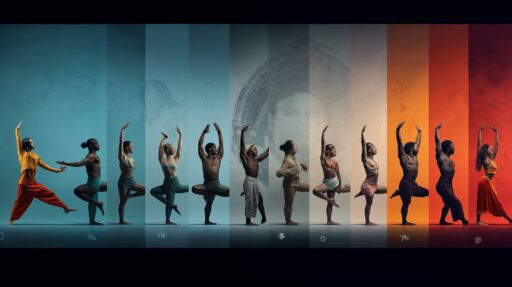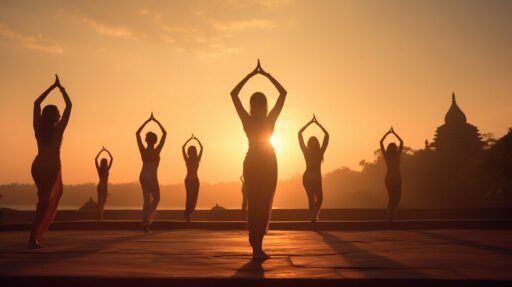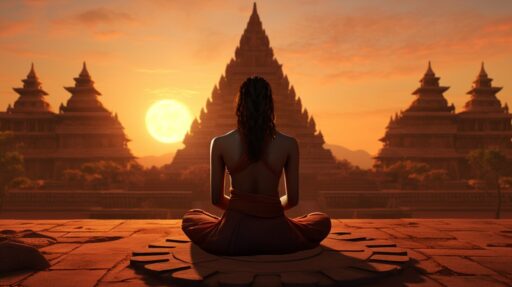Welcome to the fascinating world of yoga, an ancient practice that has intrigued and captivated individuals for centuries. If you’ve ever wondered about the origins and history of yoga, you’re in the right place. In this article, we will delve into the roots of this ancient practice, uncovering its origins and shedding light on its remarkable journey through time.
Yoga, with its rich history and deep-rooted traditions, offers a holistic approach to well-being, combining physical postures, breath control, and meditation. But where exactly did yoga originate? Let’s explore the ancient texts, civilizations, and philosophies that gave birth to this timeless practice.
Key Takeaways:
- Yoga is an ancient practice with deep historical roots.
- Its origins can be traced back thousands of years.
- Yoga has its roots in ancient India and is mentioned in ancient texts like the Rig Veda.
- The Patanjali Yoga Sutras provide practical guidance and wisdom for yoga practitioners.
- Yoga’s influence has spread across the globe, becoming a global phenomenon.
The Origins of Yoga
Yoga, a practice that has stood the test of time, has its roots in ancient civilizations and texts. While the exact origin of yoga remains a mystery, historians believe that the practice dates back thousands of years. Ancient texts and artifacts provide glimpses into the beginnings of yoga, revealing its deep historical significance.
Some historians suggest that the first yoga practices may have originated around 500 BC, while others claim that yoga has even older roots, dating back 10,000 years. The Rig-Veda, one of the oldest texts of the Indo-Aryan Civilization, contains references to the word “yoga,” indicating its presence in ancient times.
One intriguing artifact that supports yoga’s ancient origins is the Pashupati Seal discovered in the Indus Valley Civilization. This seal depicts a figure in a yogic posture, providing evidence that yoga was known and practiced during this ancient civilization, further cementing its historical significance.
| Early Origins | Rig-Veda | Indus Valley Civilization |
|---|---|---|
| Around 500 BC | Oldest text of the Indo-Aryan Civilization | Seal with yogic figure discovered |
Early Origins:
Around 500 BC – The first yoga practices
Rig-Veda:
Oldest text of the Indo-Aryan Civilization – Contains references to yoga
Indus Valley Civilization:
Seal with yogic figure discovered – Evidence of yoga practice
While the journey of yoga’s origins may be shrouded in mystery and myth, its ancient roots are undeniably profound. The practice has evolved and transformed over time, becoming a global phenomenon embraced by individuals from all walks of life.

As we explore the fascinating history and evolution of yoga, we gain a deeper understanding of its enduring legacy and the profound impact it has had on individuals throughout the ages.
Yoga in Ancient India
Explore the rich history of yoga in ancient India, where the roots of this practice were firmly established. Ancient Indian texts such as the Rig Veda, Upanishads, and Mahabharata provide valuable insights into the philosophy and practices of yoga during this time.
Yoga in ancient India went beyond physical postures and breathing techniques; it encompassed a holistic approach to well-being, emphasizing the union of the mind, body, and spirit. The ancient yogis recognized that true wellness could only be achieved through the harmonization of all aspects of one’s being.
“The philosophy and practices of yoga in ancient India emphasized the union of the mind with the Supreme Consciousness.”
The ancient yogis believed in the power of self-realization and sought to attain enlightenment through their dedicated practice. Yoga was seen as a path to connect with the divine and cultivate higher states of consciousness.
The Role of Yoga Gurus
In ancient India, yoga was passed down through generations by revered yoga gurus who served as teachers and guides. These gurus imparted their wisdom and knowledge to their disciples, ensuring the preservation and continuation of the yogic tradition.
The teachings of these gurus went beyond the physical aspects of yoga and delved into the deep philosophical underpinnings of the practice. Their guidance helped shape the understanding and practice of yoga in ancient India, leaving a lasting legacy that continues to influence modern yoga.
Table: Key Characteristics of Yoga in Ancient India
| Aspect | Description |
|---|---|
| Philosophy | Emphasized the union of the mind, body, and spirit |
| Practices | Included physical postures, breathing techniques, meditation, and ethical principles |
| Goal | Attainment of self-realization and union with the divine |
| Teaching Tradition | Passed down through generations by revered yoga gurus |
| Legacy | Influenced the understanding and practice of yoga in modern times |
Yoga in ancient India laid the foundation for the diverse and vibrant yoga practices we see today. The teachings and practices developed during this time continue to inspire and guide yoga practitioners on their spiritual journey towards self-discovery and inner harmony.

The Patanjali Yoga Sutras
The Patanjali Yoga Sutras are an invaluable ancient philosophical text that provides deep insights into the principles and practices of yoga. Composed around 500 B.C.E., these sutras serve as a guidebook for yoga practitioners seeking self-realization and spiritual enlightenment.
The Yoga Sutras, attributed to Maharishi Patanjali, consist of 196 aphorisms that systematically outline the journey of yoga. They explore the nature of the mind, the obstacles to spiritual growth, and the practices that lead to liberation. The sutras are organized into four chapters, each focusing on various aspects of yoga philosophy and practice.
One of the key teachings of the Patanjali Yoga Sutras is the eightfold path known as Ashtanga Yoga. This path offers a comprehensive framework for personal transformation and spiritual evolution. It encompasses ethical disciplines (Yamas and Niyamas), physical postures (Asanas), breath control (Pranayama), sense withdrawal (Pratyahara), concentration (Dharana), meditation (Dhyana), and ultimately, union with the Divine (Samadhi).
Through the Patanjali Yoga Sutras, practitioners gain a deeper understanding of the workings of the mind and how to transcend its limitations. The sutras provide practical tools and techniques for cultivating mindfulness, concentration, and inner stillness. They offer profound wisdom that is as relevant today as it was thousands of years ago, making the Patanjali Yoga Sutras a timeless treasure of ancient yoga philosophy.

The Philosophy of the Patanjali Yoga Sutras
The mind becomes clear and serene when the qualities of the heart are cultivated: friendliness towards those who are happy, compassion for those who are suffering, and indifference or disregard towards those we perceive as wicked or evil-minded.
The philosophy of the Patanjali Yoga Sutras revolves around the idea that the fluctuations of the mind (Chitta Vritti) are the main cause of suffering and disconnection from our true nature. Through a systematic practice of yoga, we can purify the mind and transcend these fluctuations, leading to inner peace, clarity, and self-realization.
Patanjali emphasizes the importance of cultivating ethical disciplines (Yamas and Niyamas) as the foundation of the yogic path. These disciplines guide practitioners to live with integrity, compassion, and self-discipline, creating a harmonious and virtuous way of life.
By practicing the principles outlined in the Patanjali Yoga Sutras, individuals can unlock the transformative power of yoga and embark on a journey of self-discovery, profound inner growth, and spiritual awakening.
Yoga in the Indus Valley Civilization
In our exploration of the origins and history of yoga, we cannot overlook the significant influence and presence of yoga in the ancient Indus Valley Civilization. This remarkable civilization, which thrived from 3300 to 1300 BCE in the region that is now modern-day Pakistan and northwest India, left behind tantalizing clues that point to the existence of yoga during this time.
The discovery of the Pashupati Seal, an artifact believed to date back to the Indus Valley Civilization, provides compelling evidence of yoga’s presence during this ancient era. This seal depicts a figure seated in a yogic posture, surrounded by animals, suggesting a divine connection and the practice of yoga as a means of spiritual transcendence.

Despite the limited information available about the specific practices and teachings of yoga in the Indus Valley Civilization, the existence of the Pashupati Seal and other archeological findings indicate that yoga was an integral part of the culture and spiritual life of this ancient civilization. The presence of yoga in the Indus Valley Civilization adds another layer of historical significance to this ancient practice, further solidifying its deep roots and enduring legacy.
The Pashupati Seal of the Indus Valley Civilization
| Artifact | Description | Significance |
|---|---|---|
| Pashupati Seal | Depicts a male figure in a yogic posture, surrounded by animals | Indicates the practice of yoga and its association with divinity |
| Yoga Statues | Various figurines depicting yogic postures found in excavations | Provides further evidence of the presence of yoga in the civilization |
| Harappan Civilization | City planning and architecture show alignment with Vedic principles | Suggests a connection between yoga, spirituality, and daily life |
Although the Indus Valley Civilization may not have left behind extensive written records on the philosophy and techniques of yoga, the artifacts and evidence that have been discovered affirm the practice’s existence and its relevance to the people of that time. Yoga’s presence in the Indus Valley Civilization serves as a testament to its enduring nature and the profound impact it has had throughout history.
References:
- Kenoyer, J. M. (1998). Ancient cities of the Indus Valley Civilization. Oxford University Press.
- Flood, G. D. (2003). The Indus civilization: A contemporary perspective. Rowman Altamira.
- Singh, S. (2018). The Yogic Roots of the Indus Valley Civilization. International Journal of Yoga and Allied Sciences, 7(1), 39-44. doi: 10.21474/IJAYSP-2018-7-1-08
The Evolution of Yoga
Yoga, as a practice, has undergone significant evolution throughout its long history. From its ancient roots in India to its modern global popularity, yoga has adapted to the changing cultural landscape and the needs of its practitioners. Understanding the evolution of yoga provides insights into how this ancient practice has transformed over time and continues to thrive in the present day.
One notable aspect of the evolution of yoga is the shifting emphasis on different aspects of the practice. In its early stages, yoga was primarily focused on spiritual and meditative practices, aiming to attain self-realization and union with the divine. However, over time, yoga started incorporating physical postures, breathing techniques, and cleansing practices. This expansion of yoga’s repertoire allowed it to address not only the spiritual but also the physical and mental well-being of practitioners.
The changing culture of yoga has also played a significant role in its evolution. As yoga spread to different regions and cultures, it interacted with diverse beliefs, traditions, and philosophies. This cross-pollination of ideas led to the development of various yoga paths, each with its unique teachings and practices. From the paths of knowledge and devotion to action and meditation, yoga offers a wide range of options for individuals to explore and find resonance with their own spiritual journey.
The Influence of Modern Yoga Practices
In recent decades, yoga has experienced a surge in popularity, becoming a mainstream activity embraced by people of different backgrounds and lifestyles. This increased interest has resulted in the emergence of contemporary yoga practices that cater to the specific needs and preferences of modern practitioners. Whether it’s the dynamic intensity of Vinyasa flows, the gentle restoration of Yin yoga, or the fusion of different styles, modern yoga practices showcase the adaptability and versatility of this ancient discipline.
The evolution of yoga doesn’t stop with the physical practice. Yoga has made its way into various aspects of modern life, influencing not only health and wellness but also areas such as education, workplace culture, and even scientific research. This integration demonstrates the growing recognition of yoga’s benefits and its potential to contribute to overall well-being and personal growth.

Benefits of the Changing Yoga Culture
The evolving nature of yoga and its changing culture have brought several benefits to practitioners. The availability of different yoga styles and practices allows individuals to find the approach that resonates with their unique needs, preferences, and physical abilities. This inclusivity ensures that yoga remains accessible to a wide range of people, promoting diversity and personalization in the practice.
Furthermore, the evolving nature of yoga encourages innovation and exploration within the yoga community. Teachers and practitioners are constantly experimenting with new techniques, variations, and approaches, enriching the practice and expanding its potential. This openness to change keeps yoga vibrant and relevant, ensuring that it continues to inspire and transform lives for generations to come.
| Evolutionary Milestones | Description |
|---|---|
| Origins in Ancient India | Yoga emerges as a spiritual practice rooted in ancient Indian texts and philosophy |
| Incorporation of Physical Aspects | Yoga embraces physical postures, breathing techniques, and cleansing practices to promote holistic well-being |
| Diversification of Yoga Paths | Yoga evolves into different paths, such as Jnana, Bhakti, Karma, and Raja yoga, offering diverse practices and teachings |
| Modernization and Globalization | Yoga gains popularity worldwide, leading to the development of contemporary practices and its integration into diverse cultures |
The Influences of Yoga
Yoga is more than just a physical practice; it is a holistic approach to well-being that encompasses the mind, body, and spirit. The influences of yoga can be seen in various aspects of life, guiding individuals on a path towards self-realization and union with the divine. Let’s explore some of the key influences of yoga and how they shape different yoga practices.
The Path of Knowledge
One of the influences of yoga is the path of knowledge, known as Jnana yoga. This path emphasizes the pursuit of self-understanding and wisdom through study, introspection, and contemplation. Practitioners of Jnana yoga seek to transcend physical limitations and gain deeper insight into the nature of reality. This path often involves philosophical teachings, self-inquiry, and the exploration of ancient texts such as the Upanishads and Vedas.
The Path of Devotion
Another influential path is Bhakti yoga, the path of devotion. This path centers around cultivating love and devotion towards a higher power or divine presence. Bhakti yoga practitioners express their devotion through prayers, rituals, chanting, and acts of service. By surrendering the ego and cultivating a deep connection with the divine, practitioners of Bhakti yoga aim to experience a sense of unity and bliss.
The Path of Action
Karma yoga, the path of action, is another significant influence in yoga. This path emphasizes selfless service and performing actions without attachment to the results. Karma yoga practitioners believe that by acting in accordance with one’s duty and serving others, they can purify the mind, cultivate compassion, and find spiritual fulfillment. This path teaches the importance of mindful action and the interconnectedness of all beings.
These are just a few examples of the influences of yoga and the different paths practitioners can follow. Each path offers unique practices, teachings, and philosophies that contribute to the rich tapestry of yoga as a whole. By embracing these influences, individuals can explore different aspects of themselves, connect with the divine, and cultivate overall well-being through their yoga journey.
| Influence | Description |
|---|---|
| Jnana yoga | Path of knowledge, emphasizing self-understanding and wisdom through study and introspection. |
| Bhakti yoga | Path of devotion, centered around cultivating love and devotion towards a higher power. |
| Karma yoga | Path of action, focused on selfless service and performing actions without attachment to results. |
The Global Reach of Yoga
Yoga’s impact has expanded far beyond its origins in India, reaching people of various cultures and backgrounds across the globe. Today, yoga is widely practiced and embraced by millions of individuals worldwide, making it a global phenomenon. Its physical, mental, and spiritual benefits have captivated people from all walks of life, leading to the establishment of yoga studios, retreats, and events in almost every country.
Yoga’s global reach is evident in the diverse community of practitioners who have incorporated it into their lives. From busy professionals seeking stress relief to athletes enhancing their performance to individuals on a journey of self-discovery, yoga has resonated with people seeking balance, well-being, and inner peace.
As people increasingly recognize the transformative power of yoga, its popularity continues to grow. Yoga’s widespread adoption has led to the integration of its practices in various fields, including healthcare systems, educational institutions, and corporate wellness programs. This integration highlights the recognition of yoga as a valuable tool for enhancing physical and mental health, fostering mindfulness, and promoting overall well-being.

Yoga’s Cultural Adaptation
Yoga’s global reach is not limited to physical practices and postures. It has also influenced and inspired diverse cultural expressions. Yoga’s principles and philosophy have been incorporated into different artistic forms, such as dance, music, and visual arts. This cultural adaptation showcases the enduring impact and legacy of yoga, transcending boundaries and enriching various creative disciplines.
Furthermore, yoga’s global reach has led to the emergence of hybrid yoga styles that blend traditional practices with modern influences. These fusion styles cater to the evolving needs and preferences of practitioners, offering a dynamic and innovative approach to yoga. By embracing diversity and inclusivity, yoga continues to evolve and adapt to the ever-changing global landscape, pushing the boundaries of what it means to practice yoga.
Fostering Unity and Connection
Yoga’s global reach goes beyond geographical borders, fostering unity and connection among individuals from different cultures and backgrounds. Through yoga, people from diverse communities come together to share a common journey of self-discovery, self-care, and personal growth. The universal language of yoga transcends language barriers, allowing practitioners to experience a sense of belonging and interconnectedness.
As yoga continues to spread its roots across the world, it serves as a powerful reminder of our shared humanity. Regardless of nationality, religion, or social status, yoga offers a path towards self-realization, mindfulness, and inner peace. Its global reach symbolizes the unifying potential of this ancient practice, reminding us that we are all connected in our pursuit of well-being and happiness.
The Enduring Legacy of Yoga
Yoga has a rich history that spans thousands of years and has left an enduring legacy on individuals and societies around the world. Its ancient teachings and practices continue to inspire and transform lives, offering a path for personal growth, self-discovery, and spiritual awakening. By exploring the history and roots of yoga, we can gain a deeper understanding of its profound impact and the reasons behind its enduring popularity.
Throughout history, yoga has evolved and adapted to the changing needs and cultures of practitioners. From ancient India to the modern world, yoga has been embraced in various forms and styles, each offering unique benefits and approaches to well-being. Today, yoga has a global reach, with millions of individuals incorporating it into their lives for its physical, mental, and spiritual advantages.
“Yoga is not about touching your toes, it is what you learn on the way down.” – Jigar Gor
The legacy of yoga can be seen in the countless individuals who have found solace, strength, and balance through their yoga journeys. By cultivating mindfulness, body awareness, and inner peace, yoga empowers individuals to navigate the challenges of daily life with grace and resilience. Its enduring legacy lies in its ability to transcend time and cultural boundaries, offering a universal path to well-being and self-realization.

The Impact of Yoga on Mental Health
One aspect of yoga’s enduring legacy is its impact on mental health. As individuals engage in yoga practices, they often experience reduced stress, increased relaxation, improved mood, and enhanced overall well-being. Yoga’s integration of physical postures, breathing exercises, and meditation cultivates a mind-body connection that promotes mental clarity, emotional stability, and a sense of inner peace.
| Benefits of Yoga on Mental Health | Effect |
|---|---|
| Reduced Stress | Yoga helps individuals manage stress by activating the body’s relaxation response, reducing stress hormones, and promoting a sense of calm. |
| Improved Mood | Regular yoga practice has been shown to increase levels of serotonin, a neurotransmitter associated with well-being and happiness. |
| Enhanced Self-Awareness | Yoga encourages individuals to tune in to their physical sensations, thoughts, and emotions, fostering a greater sense of self-awareness and emotional intelligence. |
| Improved Sleep | Practicing yoga before bed can help calm the mind and relax the body, promoting better sleep quality and duration. |
The Physical Benefits of Yoga
In addition to its mental and emotional benefits, yoga also offers a wide range of physical advantages. Regular practice can improve flexibility, strength, balance, and posture. It can also help alleviate chronic pain, enhance cardiovascular health, and support weight management. Yoga’s emphasis on mindful movement and breathwork promotes a greater connection to the body and promotes overall physical well-being.
- Increased Flexibility: Yoga poses gently stretch and lengthen the muscles, improving overall flexibility and range of motion.
- Strengthened Muscles: Holding yoga poses builds strength in various muscle groups, supporting stability and preventing injuries.
- Improved Balance and Coordination: Yoga poses that require balance improve proprioception, coordination, and spatial awareness.
- Enhanced Posture: Yoga helps correct postural imbalances, align the spine, and promote proper body alignment.
As we delve deeper into the enduring legacy of yoga, we begin to appreciate the profound impact it has had on individuals’ physical, mental, and spiritual well-being. From its ancient roots to its modern-day practices, yoga continues to transform lives, offering a path to self-discovery, inner peace, and a deeper connection with ourselves and the world around us.
Modern Yoga Practices
As yoga continues to evolve and adapt to the needs and preferences of practitioners, modern yoga practices have emerged, offering a wide range of options for individuals to explore and enjoy. From traditional Hatha yoga to dynamic Vinyasa flows, restorative Yin yoga, and fusion styles that blend elements from various disciplines, there is a yoga practice for everyone.
In modern yoga, the emphasis goes beyond physical postures and incorporates a holistic approach to wellness. Many contemporary yoga classes incorporate mindfulness and meditation techniques, promoting mental and emotional well-being along with physical strength and flexibility. These practices offer individuals an opportunity to cultivate inner peace, reduce stress, and enhance overall well-being in today’s fast-paced world.
One of the key benefits of modern yoga practices is their accessibility. With yoga studios, online classes, and mobile apps, individuals can easily incorporate yoga into their daily lives, no matter their location or schedule. The flexibility and convenience of modern yoga make it an ideal choice for individuals seeking to improve their physical fitness, mental clarity, and spiritual connection.
Whether you’re a beginner or an experienced practitioner, modern yoga practices provide a space for personal growth and exploration. They offer a diverse range of styles, intensities, and focuses, allowing individuals to tailor their practice to their specific needs and goals. With its continued evolution, modern yoga remains a powerful tool for self-transformation and self-care in the contemporary world.

Benefits of Modern Yoga Practices:
- Improved physical strength, flexibility, and balance
- Enhanced mental clarity, focus, and concentration
- Reduced stress and anxiety
- Increased self-awareness and mindfulness
- Promotion of overall health and well-being
- Opportunity for personal growth and self-transformation
The Future of Yoga
The future of yoga holds great promise as this ancient practice continues to evolve and adapt to the needs of modern society. With its increasing popularity and widespread acceptance, yoga is poised to make even greater strides in the years to come, both in terms of accessibility and scientific exploration.
As more and more people recognize the physical, mental, and spiritual benefits of yoga, it is likely to further integrate into mainstream healthcare systems. Yoga’s therapeutic applications are being recognized for their potential in improving various health conditions, including stress, anxiety, chronic pain, and even cardiovascular health. The integration of yoga into conventional medical practices and the development of evidence-based research will contribute to a more comprehensive and holistic approach to healthcare.
The future of yoga also holds the potential for greater inclusivity and accessibility. The practice of yoga has traditionally been associated with a certain physical ability and flexibility. However, there is a growing movement to make yoga more accessible to individuals of all body types, abilities, and backgrounds. Yoga classes and studios are embracing modifications, props, and adaptive practices to ensure that everyone can experience the benefits of yoga, regardless of their physical limitations.
Furthermore, the future of yoga will likely see more scientific exploration and research into its effects on the human body and mind. As yoga gains recognition as a valuable practice for overall well-being, the scientific community is increasingly interested in studying its physiological and psychological impacts. From exploring the effects of specific yoga poses on musculoskeletal health to investigating the neurological benefits of meditation, research in this field will provide a deeper understanding of the mechanisms through which yoga promotes health and well-being.
In conclusion, the future of yoga is bright and promising. With its ability to adapt to the changing needs of individuals and society, yoga will continue to play a significant role in promoting physical, mental, and spiritual well-being. Its integration into mainstream healthcare, emphasis on inclusivity, and scientific exploration will ensure that yoga remains a relevant and impactful practice in the modern world.

Table: Yoga’s Future Trends
| Trend | Description |
|---|---|
| Integration into Healthcare | Yoga will become more accepted and integrated into mainstream healthcare systems, with its therapeutic applications recognized for their potential in improving various health conditions. |
| Inclusivity and Accessibility | The yoga community will strive to make yoga accessible to individuals of all body types, abilities, and backgrounds, embracing modifications and adaptive practices. |
| Scientific Exploration | There will be increased scientific research into the physiological and psychological effects of yoga, providing a deeper understanding of its impacts on health and well-being. |
Conclusion
Congratulations on reaching the end of our journey through the origins and evolution of yoga. Throughout this article, we have explored the fascinating history of this ancient practice and witnessed its incredible transformation over time. Now, let’s recap what we’ve discovered about where yoga originated and its enduring legacy.
Yoga’s roots can be traced back to ancient India, with mentions of the word “yoga” found in texts like the Rig Veda and the teachings of Maharishi Patanjali in the Yoga Sutras. From its early beginnings, yoga has evolved and adapted to meet the ever-changing needs of practitioners, gaining popularity worldwide.
Today, yoga has become a global phenomenon, with millions of individuals embracing its physical, mental, and spiritual benefits. Its enduring legacy lies in its ability to inspire and transform lives, providing a path for personal growth, self-discovery, and spiritual awakening.
So, whether you’re a seasoned practitioner or just beginning your yoga journey, remember that yoga’s origins may be ancient, but its influence is timeless. It’s a practice that offers not only physical fitness but also a profound connection to your inner self and the potential for holistic well-being. So unroll your mat, embrace the teachings of yoga, and discover the transformative power within you.
FAQ
Where did yoga originate?
The exact origin of yoga is shrouded in mystery and mythology, but it is believed to have originated in ancient India thousands of years ago.
How old is yoga?
Yoga’s roots can be traced back thousands of years, with some claims suggesting it has been practiced for over 10,000 years.
What are the ancient texts that mention yoga?
Ancient Indian texts such as the Rig Veda, Upanishads, and Mahabharata contain mentions of yoga and describe its philosophy and practices.
Who is Maharishi Patanjali?
Maharishi Patanjali is attributed as the author of the Patanjali Yoga Sutras, an ancient philosophical text that presents the principles and practices of yoga.
Is yoga known to have existed during the Indus Valley Civilization?
Yes, artifacts from the Indus Valley Civilization, such as the Pashupati Seal, suggest that yoga was known and practiced during this ancient civilization.
How has yoga evolved over time?
Yoga has evolved from being practiced ritually to develop concentration to emphasizing physical postures, breathing techniques, and other aspects of well-being.
What are the different paths of yoga?
There are various paths of yoga, including Jnana yoga (the path of knowledge), Bhakti yoga (the path of devotion), Karma yoga (the path of action), and Raja yoga (the path of meditation).
How popular is yoga today?
Yoga has gained widespread popularity globally, with millions of individuals incorporating it into their lives for its physical, mental, and spiritual benefits.
What is the future of yoga?
The future of yoga looks promising, with the potential for greater accessibility, inclusivity, and integration into mainstream society, including healthcare systems and educational institutions.
How has yoga impacted people’s lives?
Yoga has had a profound impact on individuals, offering a path to self-discovery, wellness, and spiritual growth, helping them find solace, strength, and balance.
